It’s Swell
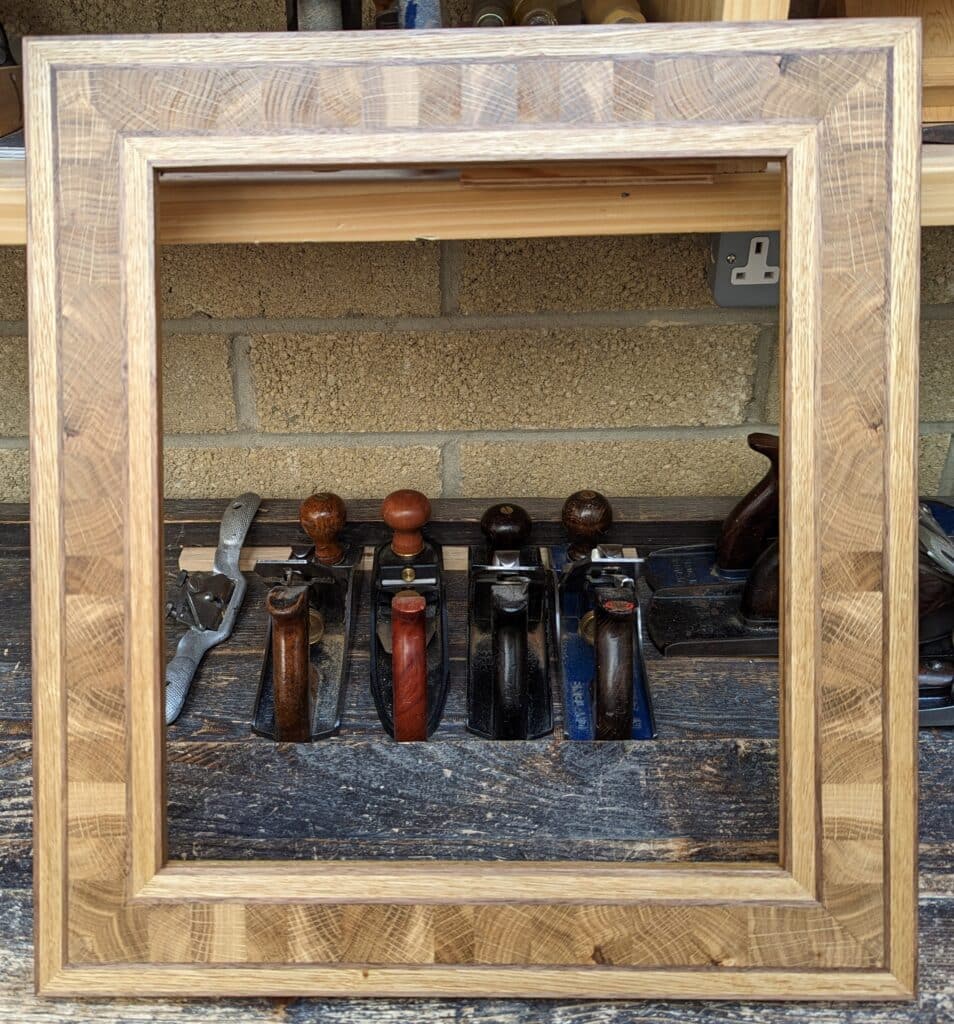
I made different versions of my latest mirror and picture frame designs. My first types went well to get from idea to finished frame and I quickly ended up with five new frames and made some decisions along the way to improve methods of making. I also grew in confidence but my confidence failed me as confidence often can when you make a seemingly minor change meant to improve something and you find your change affected things negatively in the grand scheme of designing.
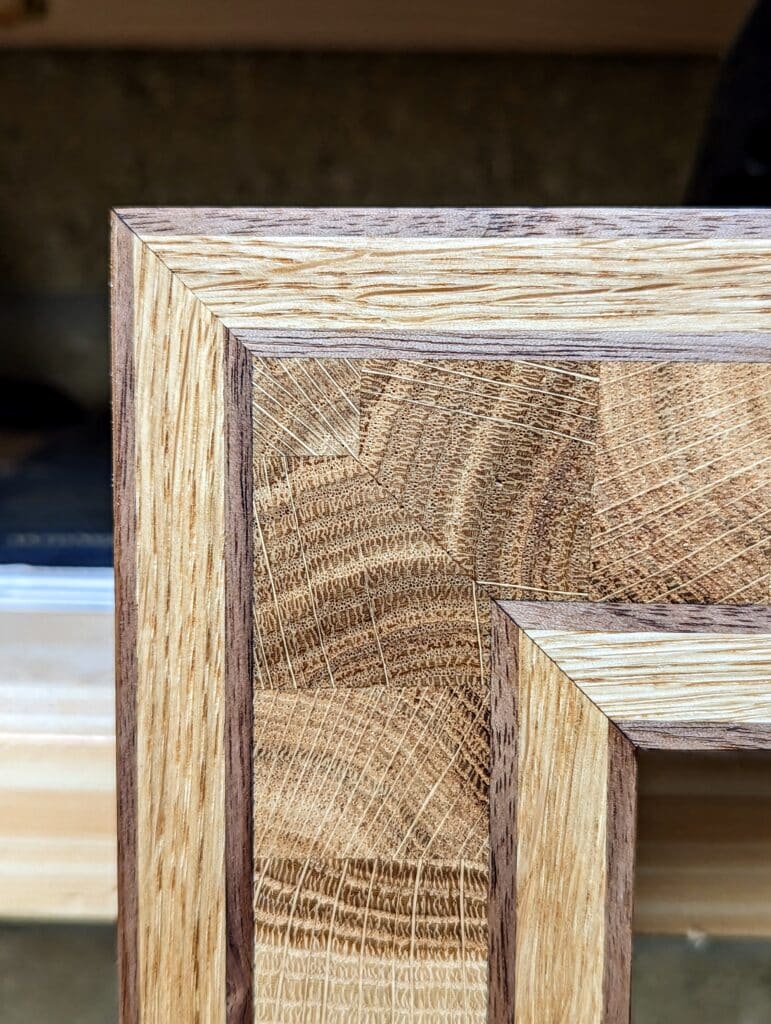
I cannot say that every mitre was perfect. These are far from conventional frames with moulds cut at 45 in a matter of a single downward cut on a powerful machine working from a rigid axis. But the cuts were close enough to nail if indeed any nails were or could be used. They weren’t, nor could they be and neither did I want to either. My quest to escape moulded stock on all things had to be success and metal, expanded foam or wood in classic Greek mouldings are no longer an option for me. Perpetuating default mindlessness and ornately carved just fills me with dread.
Glueing and clamping each of my hand-cut mitres one to the other had that mark of human hands where the smallest of gaps could be accepted but you didn’t want it when one became an eye-catching glare of a massive mistake that drew attention from a critic without a word but you’d catch the extra split-second linger of an eye on a specific point in the work. “Good enough!” I’d said to myself in the final pass of self-approval and the pressing of a clamp lever or the swivel of another. Nothing more to do now at this stage with the glue on. And there it sits ready for later scraping planing and sanding. In my first five frames, I was happy with the near-perfection I’d achieved. I doubt that a machine method would have particularly pleased me more.

So what happened on the next one? This frame was radically different to the others where the core field centred along the length was long grain. In this case, I liked the idea of using end grain and decided that book-matched end grain at the corners would be distinctive and good-lookingly different. These frames are to frame some of my personal drawings from my book Essential Woodworking Hand Tools. With all of the pieces cut and fitted to perfection, I glued and clamped the first piece in place with no lingering and everything was good. I glued the second piece to the first mitre gap-free and easily. As I worked around the corner I came to the last two mitres that had to fit simultaneously in this final glue-up. This was where something failed. I placed the piece between the two opposing end mitres and a slight difference occurred. I thought, how did this happen? Could it be ‘gain‘ in each of the mitres compounding the problem?
The end grain had taken in the water from the PVA and swelled that centre section more than the long grain sections because of the extra time it took to fit the one corner perfectly before the opposite end went down under the clamps. I was at the point of no return. The only option was to remove the section and refit after all glued components had dried, but it was too late.
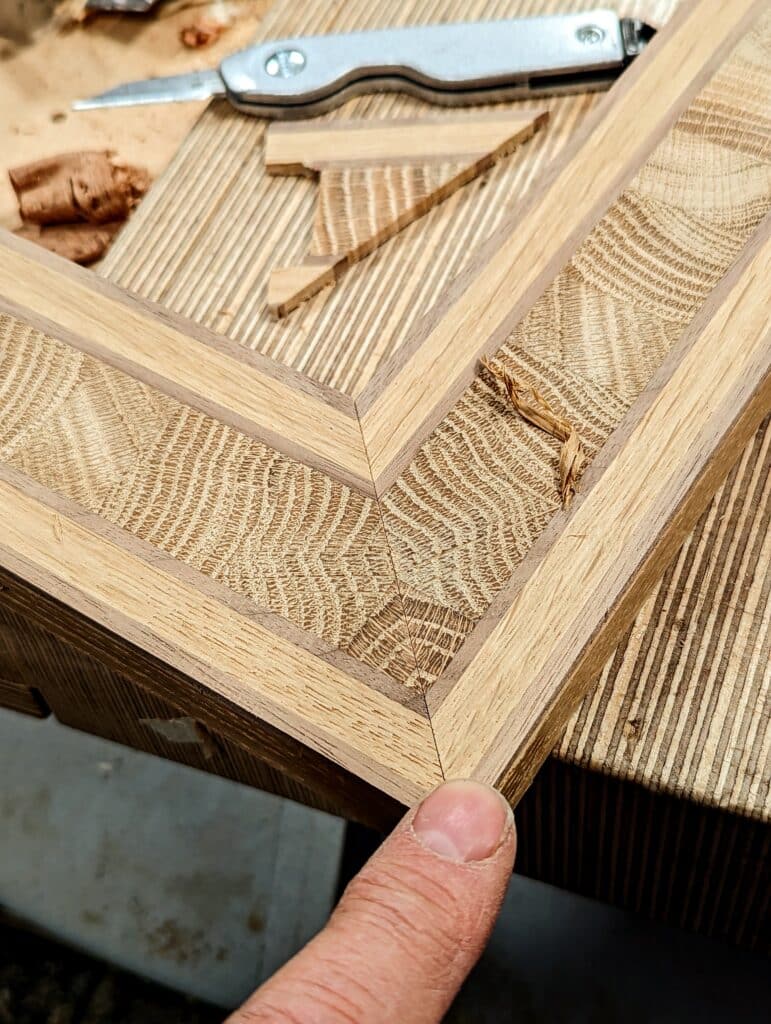
So what did I learn? I preferred not to change my glue type. PVA is a long-term glue so I preferred not to change my glue type. I decided to change my glueing-up methodology because it was simpler though a vacuum press would have been the easiest of all. What I would not want was to send my audience out to spend an unnecessary few hundred pounds when the clamping methods work fine and is plenty easy enough. Instead of glueing the pieces in succession I glued the frame and adhered the veneer facing to the frame one piece at a time and then left each piece for three hours between the sections to ensure the glue was dried independently piece by piece. I checked the mitre after the glue was cured and found the end grain section had indeed swollen very slightly and that the glue had held the wood fast to the frame. I then used a shoulder plane to correct the swollen midsection to align with the long point and heel and then fitted the adjacent pieces and glued each opposite side, left those for the three hours again and then trimmed the mitres with the should plane. It had worked on the first one and I felt confident for these two too.
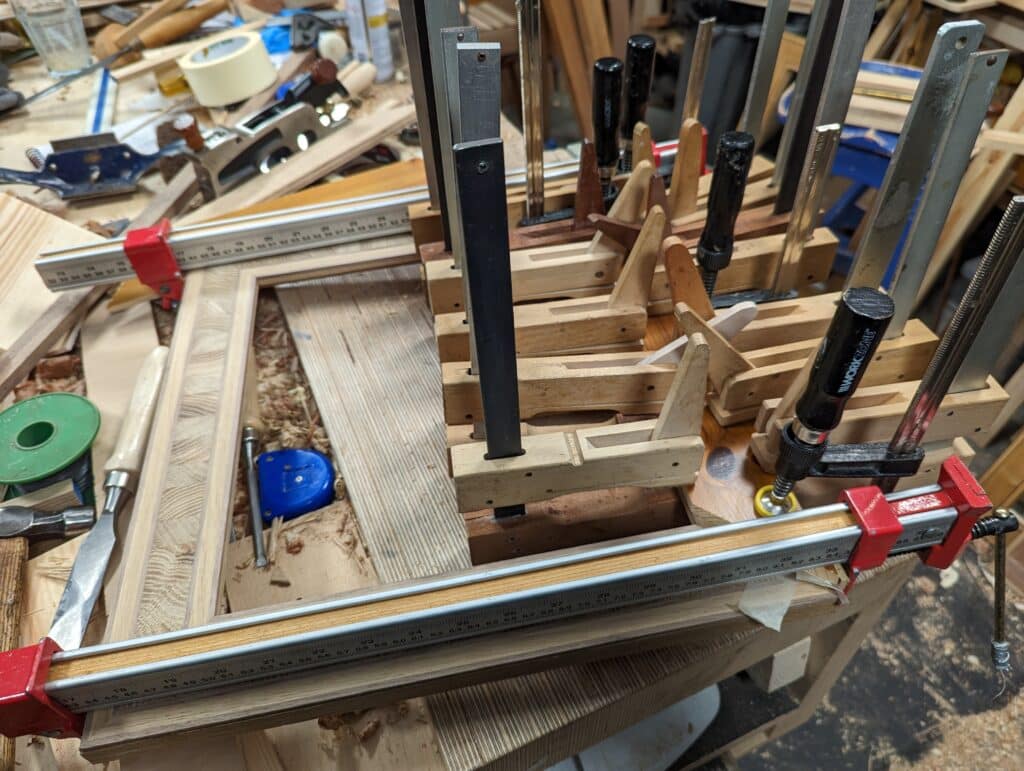
Adding in the last section between I did not hang about in the glue up. I got both mitres cut trimmed and fitted just right, stretched masking tape to pull the mitres firm to one another and then clamped it in situ to reduce the risk of swelling freely. With the long points clamped firmly, I knew there would be enough power in the clamp hold to stop any swelling to a level resulting in expansion. Adding subsequent clamps kept everything secure and pressed down. When I removed the clamps everything was just perfect.
Notes:
It’s best to apply PVA (or any water-based) glue to the main wood frame rather than the facing. This will not expand the material by any marked degree and neither will it cause any distortion. Applying the glue to the facing will cause the wood to cup into a curl as the glued side expands from the moisture of the glue.
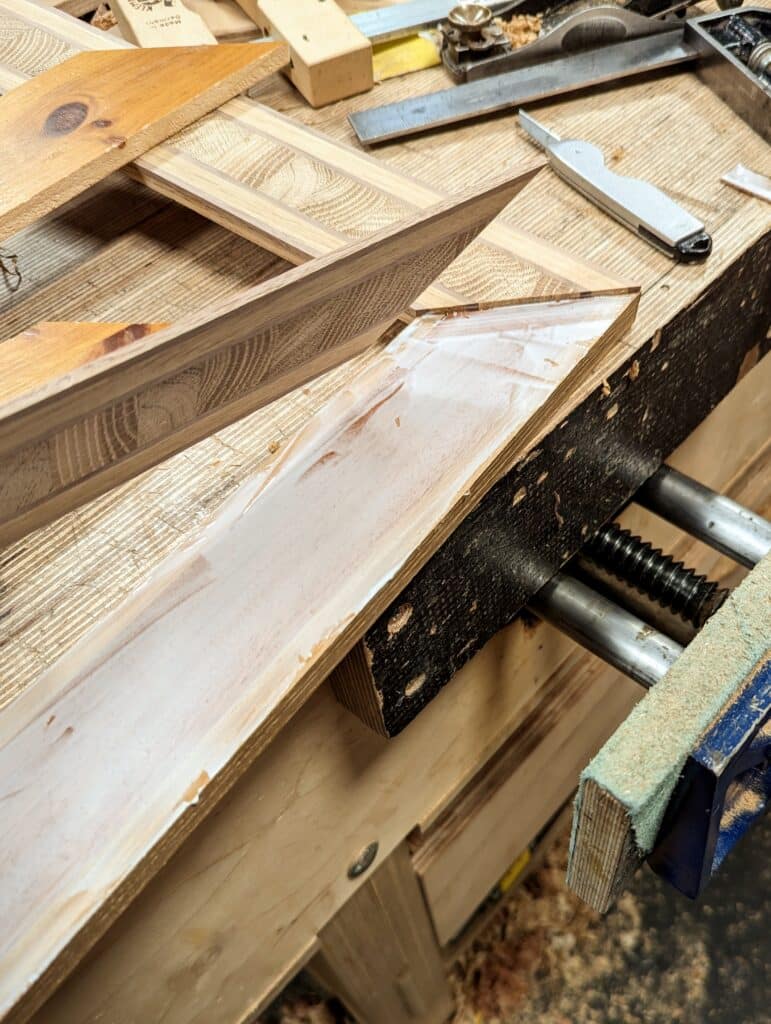
Apply the maximum amount of clamps you can and definitely use a board to distribute pressure more equally throughout the facings and minimise any risk of cavities, etc. In light of the majority not owning or having access to a vacuum press, and it might seem excessive looking at the picture below, clamps for laminates work just fine and you will always need and use these clamps over the decades to come.
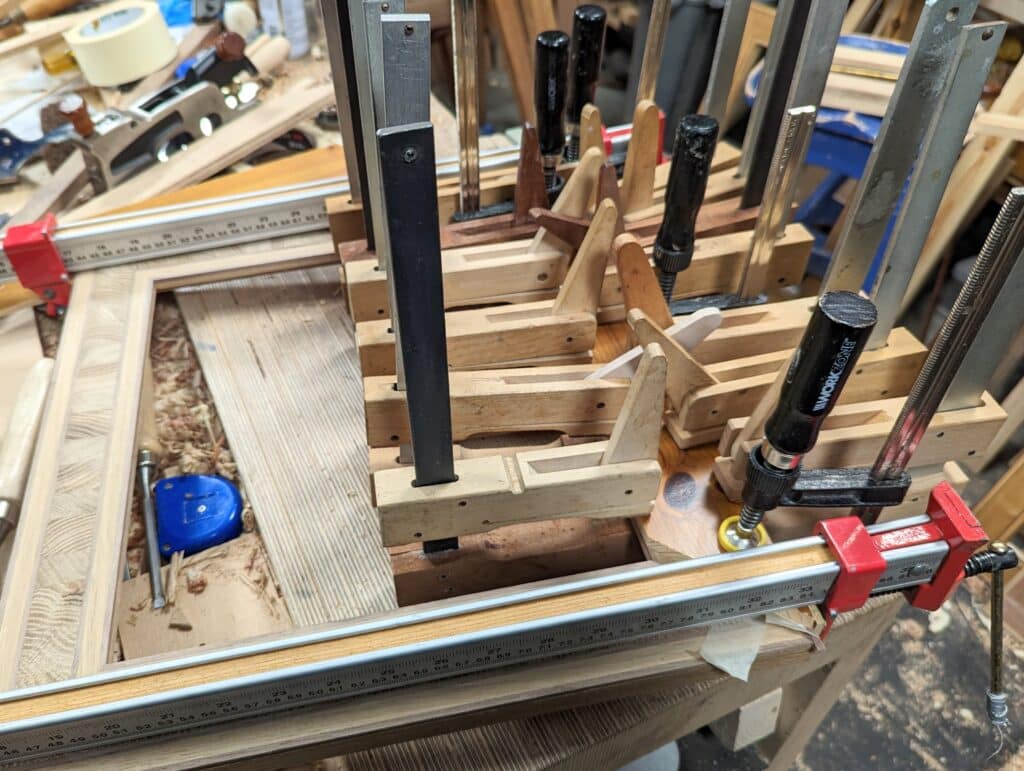
It’s important to work quickly in the glue application and the clamping process if you do indeed use the end-grain midsection especially but also on any laminate. Ensure clamping the mitres ends in place first and then work the inside clamps. Watch for the edges that are seen as sometimes these can end up slightly open.
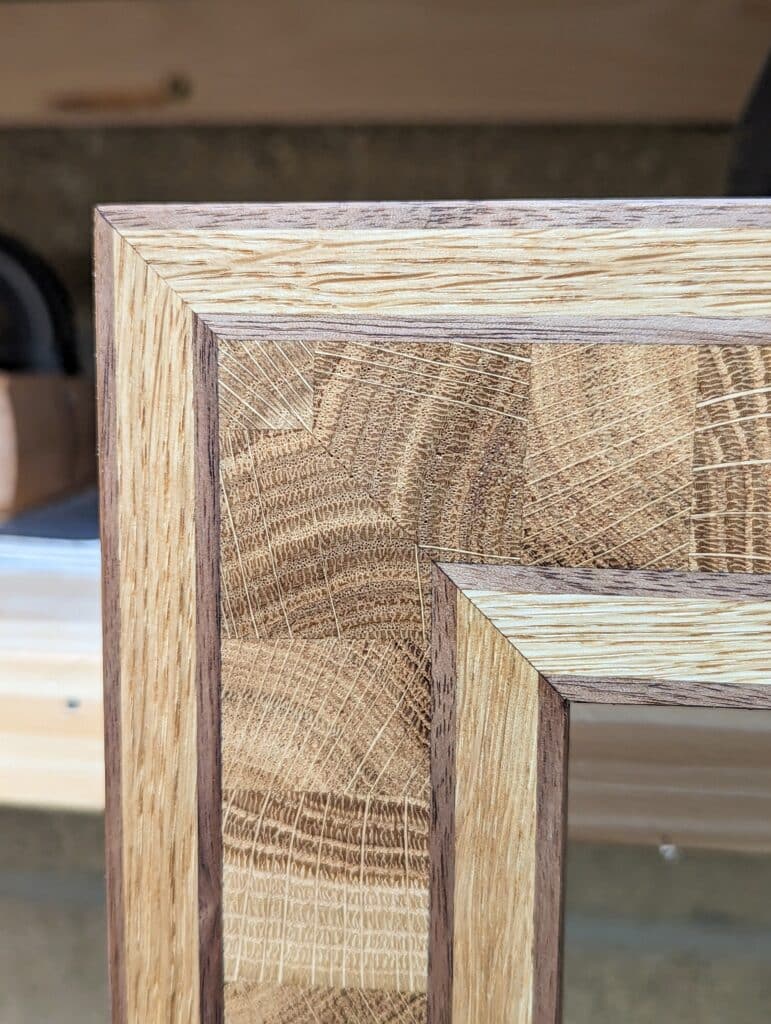
Unless all of the sides are equal in length, as in a square frame, you can only book-match three of the four corners. No one will probably notice the shortfall with the final one unless they are woodworkers.
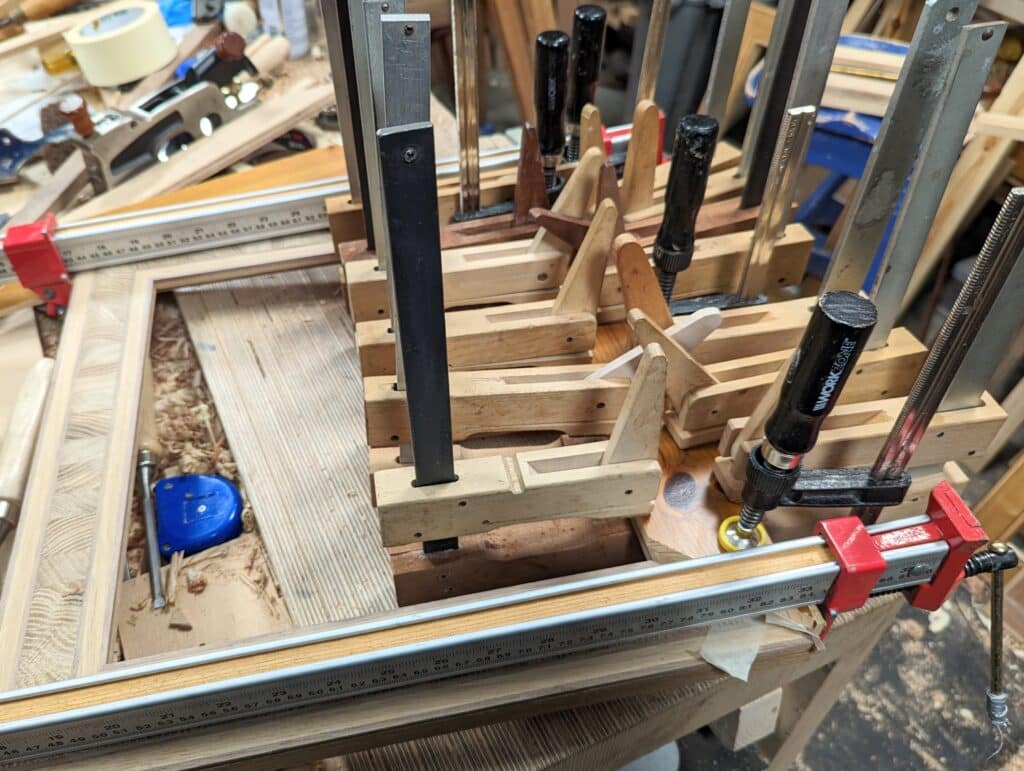
Using sash clamps at the corners helps to pull the extreme of the points in if they have indeed opened slightly. I put a small strip of the same thickness as the facing to apply pressure to the corner as the oak frame is made slightly bigger so that the edge can be planed flush to the facing when dry.



I was thinking that one would just laminate all the stock, ideally in a single piece if possible, then square the blank before cutting any mitres? I can’t tell but from the article it sounds as if you were applying the sections piece meal? If that makes sense, did you build a board with your pattern in place as the starting point? If no did you reject that method for some reason?
It depends on what you are teaching…and I am teaching. So the project is simply the vehicle I teach through. I’m teaching how to build up veneer patterns to create a panel no matter the size as a surface treatment for a veneer application. Someone who likes the concept can take the overall idea and make it however they like,
Would Beech be OK for your Cam clamp design? Without buying the wood, I have a choice of beech or oak, ignoring softwood.
Most of my clamps are heavy C, some with a ratchet, or F clamps.
Beech is as good as it gets!
Looks nice Paul. I had a similar problem with a box lid and I remember fixing it to some extent by wetting the outer edges and a small amount of moisture in the gap then running a nicely polished burnisher towards the corner many times while pushing hard along the edges. like trying to squeeze out the last bit of toothpaste from a tube. I managed to soften the wood fibre enough to close up the gap then and stretched a bit of masking tape hard around the edges with a drop of CA glue to freeze and lock the fibres. Left overnight then sand with 320G to clean up the next day. Might be worth a try. Otherwise that gap is going to annoy you every time you look at your beautiful drawings. Let me guess, the spokeshave sketches? Love that book. My wife is now reading it, she had it out of the dust cover just yesterday. You have a new fan. Thanks for all you do Paul.
I am not sure we should assume we are all the same, really. When you say, “Otherwise that gap is going to annoy you every time you look at your beautiful drawings.” it won’t. I don’t think such things should get us too hung up. Life is just like wood, it comes with knots in it . . . gaps too.
Oh and was going to ask if you thought of using band clamps instead? I find band clamps help put pressure right at the corner where you need it in situations like this, especially with a bit of masking tape or paper slid in between to apply extra pressure right at the tip.
My material is only 1/8″ thick, so wouldn’t work without crushing everything to bits. And otherwise I have never needed them anyway.
– About veneer book matching, somebody once said to me that if you have, let s’say, 4 layers of veneer, the best result would be obtained while paring layer 1 with layer 3 and layer 2 with layer 4.
What was your strategy?
– I have looked again at your video (from 5 years ago) about geometric inlaying. I don’t see myself doing end grain veneer without a bandsaw though.
Very interesting. Having read your article, were I to attempt something like that, I would probably try and laminate the end grain strips first on each frame piece, and then the outer strips of long grain material, and then finally finished the mitres before assembly. Thanks for the heads up.
I like the use of end grain for the inlay. I also like how you use the mirror image on the 45 corners. Many people may not catch that.
I wonder, when you glue up the veneer, do you need to trim it flush with the inside frame or your piece of veneer is already perfectly size? if it is trimmed, what tool do you use for that task?
the end grain look beautiful on those picture frame and your skill is mesmerizing!
I try to get it near flush but like to get the bullnose or block plane for the pristine finish to the inner edges.
End grain veneer.
What about “oyster marquetry”?
I have a dead prunus in my garden, may be I should save the trunk which is only about 15 cm in diameter. Should I make thin slices immediately after felling it, to avoid checking?
Yes, then toss it into a plastic bag for a few weeks to slow down the drying and then release it to the atmosphere it will live in a bit at a time. It’s the risk that makes it interesting.
Thank you for your answer.
I think you can get 4 bookmatched corners via a trick: Make up your banding, but make it a bit more than twice as thick as the desired final thickness. The length of the banding should equal the length plus width of the frame plus a bit of spare. For example, if your frame is 6″ x 8″ and you want 3/16″ thick banding, make up banding that is maybe 15″ long and 1/2″ to 5/8″ thick. Now, resaw the 1/2″ and open it up in a bookmatch. Notice that the tops and bottoms of the two strips are bookmatched, so when you miter them, you’ll get bookmatches at those corners.
Oh. Wait. The middle miters won’t be bookmatched at all, even if the grain flows around. So, how did you get 3 book matched corners? Did you resaw in thirds, then?
All things considered, the last one of the four I made I did not book match and it came out the most balanced in appearance. Oh, well, back to the drawing board.
I’ve been trying to things to try. Here’s an idea: Start with something that is about 8 times (!!) the desired thickness. In length, it is half the height plus half the width plus a bit more. Rip in half. Bookmatch in the long dimension, and join with a miter. You now have one corner that runs to half the height and half the width. Rip in half again and again bookmatch in the long dimension. Now, you have two bookmatched corners and a bookmatch at the center of the long side. Rip in half one final time and bookmatch. Now, you have four corners, each bookmatched. Also, two sides and two tops, both bookmatched at their middles. Of course, you can’t build it the way I described, but it was the easiest way to describe it.